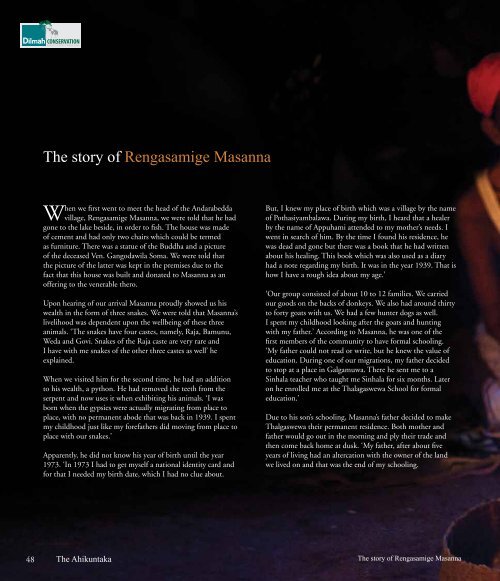The Ahikuntaka
A publication documenting the lives and livelihoods of the Ahikuntaka or gypsy community in Sri Lanka. A collection of vibrant photographs and a baseline survey on the current socio economic status of the Ahikuntaka conducted by the Colombo University complement this timely publication.
A publication documenting the lives and livelihoods of the Ahikuntaka or gypsy community in Sri Lanka. A collection of vibrant photographs and a baseline survey on the current socio economic status of the Ahikuntaka conducted by the Colombo University complement this timely publication.
Create successful ePaper yourself
Turn your PDF publications into a flip-book with our unique Google optimized e-Paper software.
www.dilmahconservation.org<br />
<strong>The</strong> story of Rengasamige Masanna<br />
When we first went to meet the head of the Andarabedda<br />
village, Rengasamige Masanna, we were told that he had<br />
gone to the lake beside, in order to fish. <strong>The</strong> house was made<br />
of cement and had only two chairs which could be termed<br />
as furniture. <strong>The</strong>re was a statue of the Buddha and a picture<br />
of the deceased Ven. Gangodawila Soma. We were told that<br />
the picture of the latter was kept in the premises due to the<br />
fact that this house was built and donated to Masanna as an<br />
offering to the venerable thero.<br />
Upon hearing of our arrival Masanna proudly showed us his<br />
wealth in the form of three snakes. We were told that Masanna’s<br />
livelihood was dependent upon the wellbeing of these three<br />
animals. ‘<strong>The</strong> snakes have four castes, namely, Raja, Bamunu,<br />
Weda and Govi. Snakes of the Raja caste are very rare and<br />
I have with me snakes of the other three castes as well’ he<br />
explained.<br />
When we visited him for the second time, he had an addition<br />
to his wealth, a python. He had removed the teeth from the<br />
serpent and now uses it when exhibiting his animals. ‘I was<br />
born when the gypsies were actually migrating from place to<br />
place, with no permanent abode that was back in 1939. I spent<br />
my childhood just like my forefathers did moving from place to<br />
place with our snakes.’<br />
Apparently, he did not know his year of birth until the year<br />
1973. ‘In 1973 I had to get myself a national identity card and<br />
for that I needed my birth date, which I had no clue about.<br />
But, I knew my place of birth which was a village by the name<br />
of Pothasiyambalawa. During my birth, I heard that a healer<br />
by the name of Appuhami attended to my mother’s needs. I<br />
went in search of him. By the time I found his residence, he<br />
was dead and gone but there was a book that he had written<br />
about his healing. This book which was also used as a diary<br />
had a note regarding my birth. It was in the year 1939. That is<br />
how I have a rough idea about my age.’<br />
‘Our group consisted of about 10 to 12 families. We carried<br />
our goods on the backs of donkeys. We also had around thirty<br />
to forty goats with us. We had a few hunter dogs as well.<br />
I spent my childhood looking after the goats and hunting<br />
with my father.’ According to Masanna, he was one of the<br />
first members of the community to have formal schooling.<br />
‘My father could not read or write, but he knew the value of<br />
education. During one of our migrations, my father decided<br />
to stop at a place in Galgamuwa. <strong>The</strong>re he sent me to a<br />
Sinhala teacher who taught me Sinhala for six months. Later<br />
on he enrolled me at the Thalagaswewa School for formal<br />
education.’<br />
Due to his son’s schooling, Masanna’s father decided to make<br />
Thalgaswewa their permanent residence. Both mother and<br />
father would go out in the morning and ply their trade and<br />
then come back home at dusk. ‘My father, after about five<br />
years of living had an altercation with the owner of the land<br />
we lived on and that was the end of my schooling.<br />
48 <strong>The</strong> <strong>Ahikuntaka</strong><br />
<strong>The</strong> story of Rengasamige Masanna















